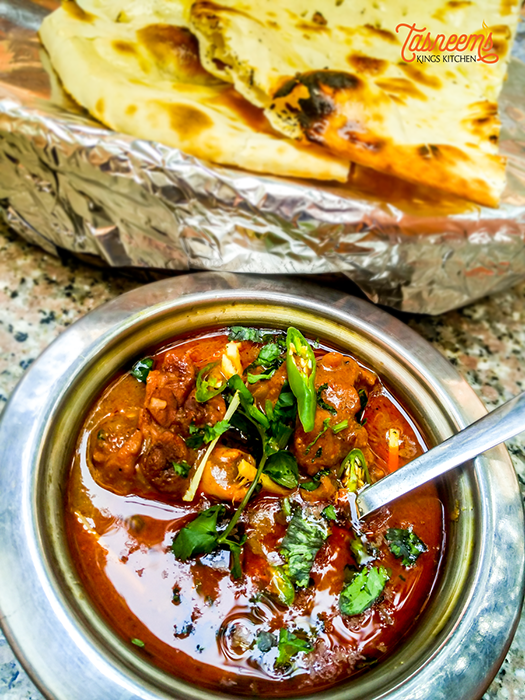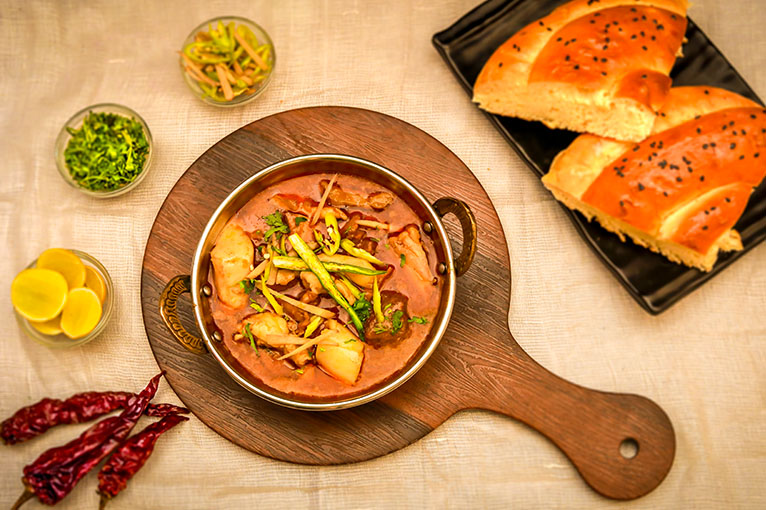Nihari Mutton – From the Royal Kitchens of Awadh
Nihari (Urdu: نهاری) is a stew consisting of slow-cooked meat mainly mutton along with bone marrow.
The word Nihar originated from the Arabic word “Nahar” which means “day” as it was typically served after sunrise Fajr prayers.
According to many sources, Nihari either originated in old Delhi (Jama Masjid and Daryaganj areas areas) in the late 18th century during the last throes of the Mughal Empire or in the royal kitchens of Awadh, in modern day Lucknow, Uttar Pradesh, India. The Nawab ate Nihari early in the morning after Fajr prayers and then took a long nap before going to Zhuhr (afternoon Muslim prayers). Later on, it became popular among the labor class as a regular breakfast item.
Another story reveals that Nihari was cooked overnight in large volume to be served to the labourers. Whenever there were massive constructions involved and the kings served meals free to labour and also paid them. In some instances kings did not  want to offer coins / currencies, they in turn offered free meals and accommodations to the labourers. Since the work had to be started in the morning, it was cooked in an earthern pot, sometimes even buried and served in the morning to ensure the supply of energetic labour force. Alternative origins puts roots in the Muslim Nawab kitchens, having achieved fame via the storied royal kitchens of Lucknow.
want to offer coins / currencies, they in turn offered free meals and accommodations to the labourers. Since the work had to be started in the morning, it was cooked in an earthern pot, sometimes even buried and served in the morning to ensure the supply of energetic labour force. Alternative origins puts roots in the Muslim Nawab kitchens, having achieved fame via the storied royal kitchens of Lucknow.
Nihari developed with the overall cuisine of south Asian Muslims. It has been an old popular delicacy in parts of Bangladesh, particularly Dhaka and Chittagong. People cooked it for one whole night and they got it in the early morning at sunrise. It is a popular dish and is regarded as the national dish of Pakistan. The dish is known for its spiciness and taste. It was originally more of a delicacy with myriad variations on spiciness and texture.
Nihari is cooked overnight in various vessels, sometimes even buried underground while it cooks overnight, which results in extremely tender morsels of meat, including the flavourful bone marrow. It is served with a number of side dishes. The baghaar is lightly fried in ghee to reduce the heat of chilis and the tarka is an additional oily chili to spice up the flavour.
Cooked bone marrow is served alongside the stew. The Nihari is garnished according to individual tastes with coriander leaves, fried onions, green chillies, strips of ginger, lemons and sliced white radishes. In addition, garam masala, a blend of powdered spices is sprinkled over the stew. Salt is added to taste. In restaurants many of the garnishings are already added to increase customer turnover.
Traditional nihari recipes call for 6–8 hours of cooking time, in addition to the preparation of the ingredients. This is much less common today with the use of tenderer cuts of meat such as sirloin or shank. Traditionally the dish is eaten in the early hours of the morning. Because the stew is so rich, one is supposed to have an extended nap until the afternoon Muslim Zhuhr prayers, which occur after midday.
Pippali is the main spice used in nihari, which gives it a distinct taste and aroma. It is eaten with naan or roti.
In some restaurants, a few kilos from each day’s leftover Nihari is added to the next day’s pot. This re-used portion of Nihari is called Taar and is believed to provide the unique flavour. Some Nihari outlets in old Delhi still boast of an unbroken taar going back more than a century.
In Kathmandu you can enjoy authentic Awadhi style Nihari Mutton every weekend at Tasneem’s Kings Kitchen, next to Pulchowk Fire Brigade, Jhamsikhel Road, Lalitpur Nepal. It is a super speciality dish and takes over 6-8 hours of cooking, it is made in limited quantity. Please do call 9801121212 and book your Nihari Mutton to avoid disappointment.
You can also order Nihari Mutton by the kilo for your house parties.


Comments are closed.